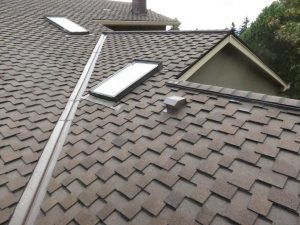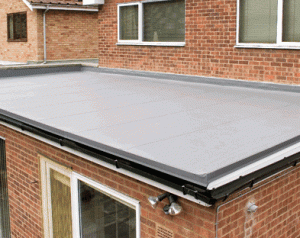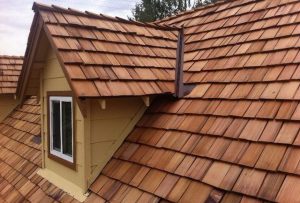What Are The Most Common Types Of Roofs?
If you are in need of a new roof for your home, you no doubt have been doing at least some preliminary research. While this is a good thing, you may be a little confused about the options available to you. You may also feel a bit lost in regards to the different types of roofing material that you can choose from. That is where we can come in and lend a helping hand! With decades of experience with all manner of residential roofing materials, the Stay Dry Roofing team can help you get the new roof that is just right for your home. Here are some of the most common type of roofing material we use with our customers today in Indianapolis:
Asphalt Shingles
Asphalt shingles have been used on roofs for over 100 years. They were created right here in the United States in 1903. At first, these shingles were made of rags, but eventually, manufacturers were looking for a roofing material that was more fire retardant. That’s because there were not many fire departments in service in the country at that time, and once a home caught on fire, it burned easily. Asphalt is very fire retardant, which makes them a great choice for roofing material. Currently, asphalt shingles are made from either fiberglass or another material and then covered in asphalt. Some shingles are covered with asphalt on one side only, while other shingles have asphalt on both sides. The shingle top is then coated with stone such as mica, schist or quartz. The back of the shingle has sand, mica or talc, which helps the shingles stick together on the roof.
These are the shingles that have been the most popular choice among roofers and homeowners alike for decades. This popularity is due largely to the fact that they are so durable and are the most inexpensive of all roofing options. Other benefits include the ability to get them in a wide range of colors as well as the fact that they hold up well to extreme temperatures. Asphalt shingles also provide reliable waterproofing and are fairly easy to install for a quick upgrade project. Most asphalt shingles have a lifespan of around 20 years, and in some cases, they can last as much as 30-40 years with proper care and maintenance. The major drawback to asphalt shingles as roofing materials is that they do not hold up well to foot traffic and can be prone to problems in high wind areas. . If you are using asphalt shingles in areas prone to severe thunderstorms and hail, the shingles can be damaged by high wind or hailstones and become dislodged. They also can be a bit heavy when used on larger roofs, so this needs to be taken into account as well when making your decision.
Slate and Tile
Slate shingles may well be the answer you have been looking for if you need something a bit classier and more modern looking for your home’s roofing system. Homeowners have been using slate on rooftops since the 1700’s in the United States. Slate is a stone that is from areas with a lot of clay or volcanic ash. Slate was very expensive when it was first used, and only lords and ladies could afford a slate roof. New ways of process slate have led to slate roofs becoming more economical as a roofing choice. Advantages of slate are its natural appearance, superior fire resistance, durability, and up to a 100 years lifespan. Slate as a roofing material is just plain gorgeous and has been used by architects for hundreds of years, because of its beauty. Slate is also impervious to a lot of weather disasters that spell trouble for other roofing materials. It naturally resists high winds, tons of rain and hail. In fact, slate roofs can resist damage from hail that is up to four inches in diameter. That’s softball size! Slate is available in a variety of colors and styles, making it a great choice for a new roof installation upgrade. The biggest disadvantages of slate tile are that they are quite heavy and do not hold up to foot traffic well at all. Another big disadvantage to putting a slate roof on is the cost. Natural slate roofs cost more money to manufacture than asphalt shingles do, and they also require expert installation to last a long time. If you have the money, slate roofs are amazing. However, you need to think about the costs of a slate roof before you commit to one.
Ceramic roofing tiles have been around for centuries. In fact, some of the oldest societies in the world have used ceramic roofing tiles on their roofs as well as inside their homes. This is particularly true in Mesopotamia, where you can see decorative tiles that are thousands of years old.
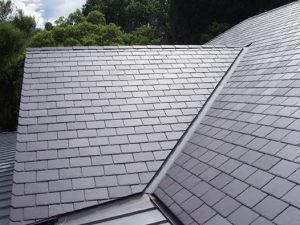
Disadvantages most Indianapolis homeowners find with these tiles is their susceptibility to impact damage from hail and storm debris as well as possible fading in extreme heat and sun exposure. Another disadvantage to tile roofs is they can be quite heavy, so additional roofing supports may need to be added to bear the weight. Perhaps the largest disadvantage to having a ceramic roof is the cost. Between the cost of manufacturing ceramic tile roofs and the costs of construction, ceramic tile roofs can cost two to three times what an asphalt roof installation can cost, especially if additional roof supports need to be added.
Metal Roofing
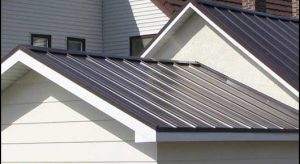
Flat Roof System
Flat roofs are typically less expensive when it comes to installation and many homeowners like the added safety of a flat roofing surface. They are usually easy to access and in some settings, they do have a certain aesthetic appeal. Many homeowners who have ranch houses from the mid-century modern period love flat roofs, because that was the standard for homes immediately after World War II, and they do have a certain charm. Flat roofs are the most common type of roofing system used in commercial properties today, but they are not as common in the residential setting. This is largely due to the fact that they can require a good bit of maintenance, especially if you live in an area that gets a lot of rain, snow, or high-temperature ranges. Flat roofs are mostly flat- they have a slight slope to allow for water drainage. It is important to make sure the roof stays clear of leaves, limbs, and debris so that water and snow do not get trapped and accumulate on the roof. This type of roofing material has a lifespan of only about 15 years and then it will need to be replaced. In most cases, a flat roof is not recommended for residential application. It’s easy to understand why if you are living in the Midwest. We experience a lot of dry periods during the winter, but we also get periods of intense rain and snow, which could collapse a flat roof. You’ve seen enough of those on TV to know that you don’t want it to happen to you.
Wood Shakes
While it might not seem like it at first glance, wood shakes roofing materials is a great choice for the environmentally friendly homeowner. Though they are made from wood, most shake roofing shingles and panels are made from renewable sources and are harvested and prepared in a way that has less impact on the environment. This is especially true if you decide to use recycled or refurbished wood for your roofing upgrade. Wood roofs are also popular among those who are straying to reduce their carbon footprint because it has little to no effect on rainwater runoff. This means there is no concern about harmful byproducts getting into the soil, affecting your landscape plants, or getting into the groundwater. They are also becoming more popular because wood shake has a useful life of up to 50 years with proper care and maintenance. They are a bit costlier to install in Indianapolis, but their lifespan and lack of environmental impact, along with a stunningly rustic and beautiful finish, makes them a solid investment in your home’s roofing system.
Contact the Roofing Experts Today
If you have questions about the roofing material that is right for you and what options are right for your unique wants and needs, give us a call! Our team of roofing experts can help you make the right decision and can help you get your roofing system installed quickly and easily. Call today and ask us about our free consultation and get the new roof of your dreams with the roofing materials that are just right for your home. Call now to get started with your new roofing installation in Indianapolis!

